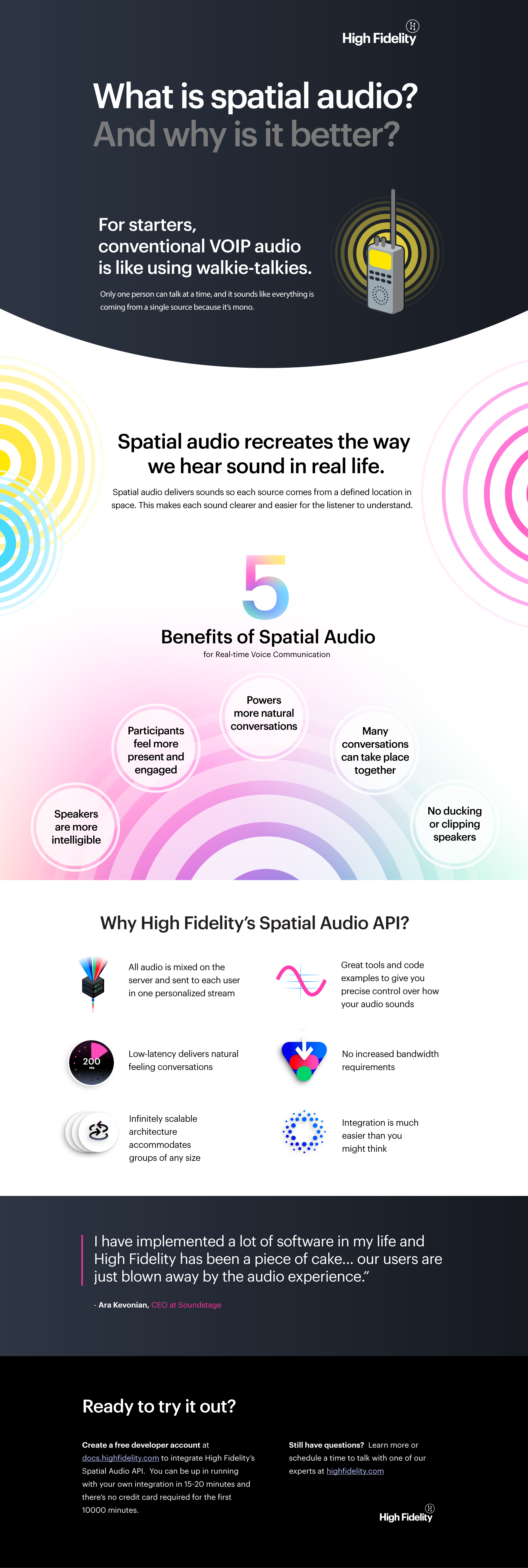An Overlooked Solution For 'Virtual Event Fatigue'
There are countless articles, tweets, and LinkedIn posts from marketers and others expounding upon the future of virtual events and conferences; how ...
In recent months, spatial audio has become one of the most talked-about next-generation technologies on the market. In fact, Apple recently announced that Apple Music and tvOS would soon support spatial audio.
Grammy Award-winning producer, songwriter, and composer Giles Martin described spatial audio as the “quantum leap in technology”.
“From the feeling of hearing your favorite artists in the room as you, to the experience of sitting directly in the middle of a symphony orchestra, the listening experience is transformative and the possibilities for the creator are endless,” said Martin.
Today, thousands of industry-leading developers and audio engineers use spatial audio to create powerful and immersive experiences. The best part is that the use cases for spatial audio are virtually limitless. From videoconferencing to virtual events, spatial audio has the potential to change the way people consume audio content and leverage real-time voice technologies forever.
If you’re new to the concept of spatial audio or wondering how your own application might leverage the power of this immersive technology, you’re in the right place. As a leading provider of real-time spatial audio, we’ve worked hand-in-hand with some of the world’s most promising startups and scale-ups.
And the results have been phenomenal.
“Using High Fidelity means much better audio quality, more accurate 3D sound, lower latency, more cross-browser compatibility, many more simultaneous audio streams per room, and a much better experience for everyone,” says Adam Baio, CEO at Skittish.
Is spatial audio right for your unique application?
To find out, we’ve prepared a short visual guide below. If you’re planning for your next build or reconsidering your current application’s audio environment, use this guide to learn more about the unique features and benefits of spatial audio.
So what is spatial audio exactly?
“Popularized by the rise of virtual reality, spatial audio is the technique whereby sounds are processed to make them appear to come from their real location in space,” said High Fidelity Co-founder and CEO, Philip Rosedale, in What is Spatial Audio?
“There are two techniques used to move sounds left/right and in-front/behind you,” continued Rosedale. “Combined these techniques are often referred to by the acronym of HRTF which stands for Head Related Transfer Function.”
To spatialize sound, engineers shift the time delay between both left and right channels, and adjust the loudness of frequencies relative to the unique position of your head.
Fortunately, we’ve taken the legwork out of audio spatialization with our Spatial Audio API. With just a few lines of code, teams can easily add high quality, real-time chat to any videoconferencing or virtual events application – it’s that easy!
RELATED READING: 5 Ways Brands are Using Immersive Technology in 2021

**For those using a screen reader, please see the end of the blog post for the full text from the infographic.
Of course, this is all just theory. What does spatial audio actually sound like?
“When people talk at the same time, you need spatial audio to be able to understand them,” said Rosedale. This is the ‘cocktail party’ effect, where the separation of people’s voices in space is what the brain uses to understand multiple voices at once.”
You’ll want to grab a pair of headphones to experience the full power of spatial audio. In the example above, notice how much easier it is to process each participant’s voice. When compared to conventional VOIP audio, spatial audio delivers unparalleled audio clarity.
RELATED READING: Virtual Events Tips: Does Audio Matter?
Here are a few other great examples of spatial audio in practice:
Skittish: Skittish offers a playful and interactive virtual meeting space where participants can “dress up” as a colorful animal avatar, such as a cow or a pig. This rich and dynamic virtual environment comes with powerful spatial audio baked right in.
Skittish utilizes our Spatial Audio API to deliver improved audio quality and three-dimensional sound at low latency.
“Instead of trying to connect every person in the space to one another, we now send audio streams and positional information to High Fidelity’s servers, where they transform it into a personalized spatial sound collage,” said Skittish creator Andy Baio.
Vatom: Vatom (formerly named SpatialWeb) promises to change the way users interact with one another through the provision of three-dimensional virtual spaces. From cross-team collaboration to networking, Vatom delivers all the tools needed to foster increased togetherness, even when users are thousands of miles apart.
Recently, MediaLink and iHeartMedia partnered with Vatom to recreate a virtual rendition of the Las Vegas Convention Center. The virtual event was hosted by Ryan Seacrest and featured a variety of Grammy-winning artists, including Dua Lipa, Chris Martin, and Billie Eilish.
“We could create remote togetherness, at a time when actual in-person gathering is limited,” said iHeartMedia Chairman and CEO Bob Pittman.
RELATED READING: The Best 3D Audio Experience Examples
Today, accelerated by popular videoconferencing systems, online gaming, and virtual events platforms, spatial audio has the potential to revolutionize a variety of industries.
In short, immersive, high quality spatial audio enhances the user experience within any digital space and integrating this technology is relatively straightforward. However, if you’re planning on adding spatial audio to your application, know that not all spatial audio providers are created equal. For this reason, it’s critically important to partner with a solutions provider that delivers all the features you need.
RELATED READING: 3 Major Benefits of Spatial Audio
High Fidelity is one of the few spatial audio providers that gives developers and audio engineers full control over the entire audio environment. Thousands of industry-leading app development teams rely on us to deliver the following features and benefits:
When compared to other spatial audio providers, High Fidelity is a cut above the rest:
RELATED READING: How to Use a Spatial Audio API When Building a Simple Web App
The benefits of spatial audio are boundless. How will you use this immersive technology to level up your application’s audio environment?
To get started, we invite you to create your free developer account.
High Fidelity can process hundreds of sound sources in real-time and in less than 15 minutes, you can launch a simple web application using immersive audio. The number of use cases for spatial audio are virtually limitless.
“We needed to specify our users’ locations without sacrificing the quality of the audio. High Fidelity does that perfectly. I’m so happy,” says Soo Ling Lim, CEO at Hubbub.
Our Spatial Audio API allows you to integrate real-time voice communication for hundreds of users without any additional bandwidth requirements. Additionally, access full developer control to easily manipulate positioning, room attenuation, and other aspects of the audio environment. Are you ready to get started?
**For those using a screen reader, please see below for the full text on the large infographic above.
What is spatial audio? And why is it better? For starters, conventional VOIP audio is like using walkie-talkies. Only one person can talk at a time, and it sounds like everything is coming from a single source because it's mono.
Spatial audio recreates the way we hear sound in real life. Spatial audio delivers sounds so each source comes from a defined location in space. This makes each sound clearer and easier for the listener to understand.
5 Benefits of Spatial Audio for Real-time Voice Communication
Why High Fidelity's Spatial Audio API?
"I have implemented a lot of software in my life and High Fidelity has been piece of a cake... our users are just blown away by the audio experience." — Ara Kevonian, CEO at Soundstage
Ready to try it out? Create a free developer account at docs.highfidelity.com to integrate High Fidelity’s Spatial Audio API. You can be up in running with your own integration in 15 to 20 minutes and there’s no credit card required for the first 10000 minutes. Still have questions? Learn more or schedule a time to talk with one of our experts at highfidelity.com.
Related Article:

by Ashleigh Harris
Chief Marketing Officer
There are countless articles, tweets, and LinkedIn posts from marketers and others expounding upon the future of virtual events and conferences; how ...
Subscribe now to be first to know what we're working on next.
By subscribing, you agree to the High Fidelity Terms of Service